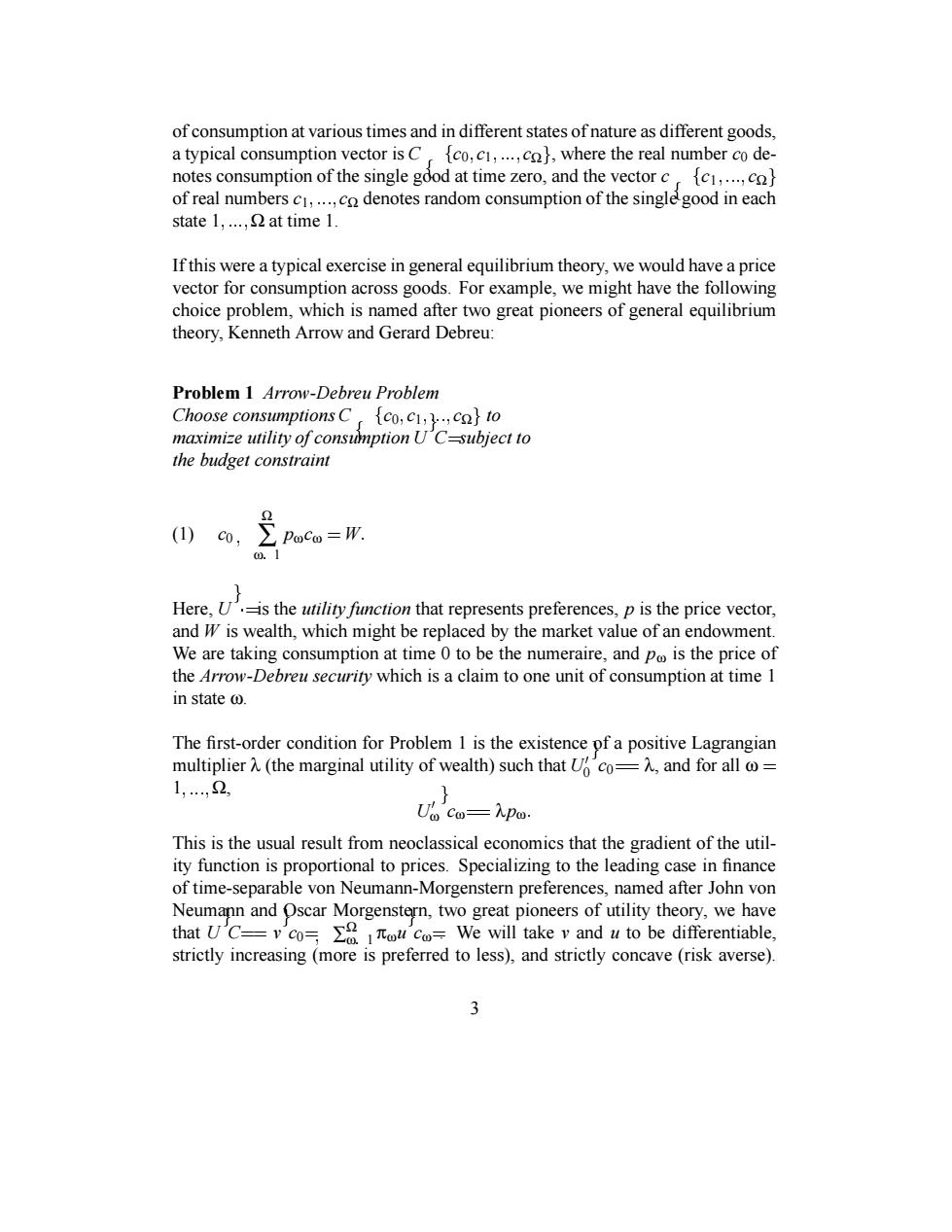正在加载图片...

of consumption at various times and in different states of nature as different goods, a typical consumption vector is C fco,c1,..,co,where the real number co de- notes consumption of the single gdod at time zero,and the vector c tc1,...,co of real numbers c1,...,co denotes random consumption of the single good in each state 1,...,at time 1. If this were a typical exercise in general equilibrium theory,we would have a price vector for consumption across goods.For example,we might have the following choice problem,which is named after two great pioneers of general equilibrium theory,Kenneth Arrow and Gerard Debreu: Problem 1 Arrow-Debreu Problem Choose consumptions C co,c1,.,co to maximize utility of consumption U'C-subject to the budget constraint 2 (1) Poco=W. 0.1 Here,U'.-is the utility function that represents preferences,p is the price vector, and W is wealth,which might be replaced by the market value of an endowment. We are taking consumption at time 0 to be the numeraire,and p is the price of the Arrow-Debreu security which is a claim to one unit of consumption at time 1 in state o The first-order condition for Problem 1 is the existence of a positive Lagrangian multiplierA(the marginal utility of wealth)such that UcoA,and for all= 1,,2 Uoco-hpo: This is the usual result from neoclassical economics that the gradient of the util- ity function is proportional to prices.Specializing to the leading case in finance of time-separable von Neumann-Morgenstern preferences,named after John von Neumann and Oscar Morgenstern,two great pioneers of utility theory,we have that U'c-cWe will take v and u to be differentiable, strictly increasing (more is preferred to less),and strictly concave(risk averse). 3of consumption at varioustimes and in different states of nature as different goods, a typical consumption vector is C c0 ✄ c1 ✄ ☎✞☎✝☎✞✄ cΩ ✁ , where the real number c0 denotes consumption of the single good at time zero, and the vector c c1 ✄ ☎✝☎✞☎✝✄ cΩ ✁ of real numbers c1 ✄ ☎✝☎✞☎✝✄ cΩ denotes random consumption of the single good in each state 1 ✄ ☎✞☎✝☎✞✄ Ω at time 1. If this were a typical exercise in general equilibrium theory, we would have a price vector for consumption across goods. For example, we might have the following choice problem, which is named after two great pioneers of general equilibrium theory, Kenneth Arrow and Gerard Debreu: Problem 1 Arrow-Debreu Problem Choose consumptions C c0 ✄ c1 ✄ ☎✝☎✞☎✝✄ cΩ ✁ to maximize utility of consumption U ✁ C ✂ subject to the budget constraint c0 ✄ Ω ∑ ω☎1 (1) pωcω ✂ W ☎ Here, U ✁✝✆ ✂ is the utility function that represents preferences, p is the price vector, and W is wealth, which might be replaced by the market value of an endowment. We are taking consumption at time 0 to be the numeraire, and pω is the price of the Arrow-Debreu security which is a claim to one unit of consumption at time 1 in state ω. The first-order condition for Problem 1 is the existence of a positive Lagrangian multiplier λ (the marginal utility of wealth) such that U ✞ 0 ✁ c0 ✂ ✂ λ, and for all ω ✂ 1 ✄✆☎✝☎✝☎✞✄ Ω, U ✞ ω ✁ cω ✂ ✂ λpω ☎ This is the usual result from neoclassical economics that the gradient of the utility function is proportional to prices. Specializing to the leading case in finance of time-separable von Neumann-Morgenstern preferences, named after John von Neumann and Oscar Morgenstern, two great pioneers of utility theory, we have that U ✁ C ✂ ✂ v ✁ c0 ✂ ✄ ∑ Ω ω☎1 πωu ✁ cω ✂ . We will take v and u to be differentiable, strictly increasing (more is preferred to less), and strictly concave (risk averse). 3